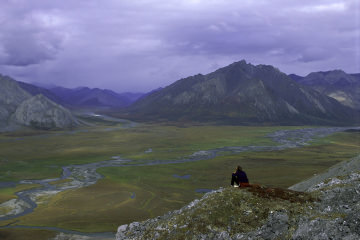Every spring, the Porcupine Caribou Herd embarks on a 400-mile, journey that takes them across wide, ice-cold rivers and up steep mountain passes enroute to the tundra plains of northern Alaska. Tucked between the freezing waters off the Arctic Ocean and the towering Brooks Range to the south, the plains are inhospitable in winter, but protected in summer from Alaska’s deadly mosquito population by steady ocean breezes. The pregnant caribou take the lead, arriving on the tundra by early summer, when conditions are ideal for giving birth. As many as 40,000 calves are born here each year. Along with the rest of the herd, they’ll stay until the summer ends and the wind turns cold, before beginning the fall migration south to their winter range in the boreal forests.
No one knows the intricacies of the Porcupine Caribou Herd’s yearly migration better than the Gwich’in, an Alaska Native tribe whose people have lived in the region for over 20,000 years. Today, 9,000 Gwich’in in 13 settlements continue to live, as their ancestors did, along the caribou’s migratory route. And while some aspects of the modern world have crept into their remote villages—satellite TV and snowmobiles—the staples that most Americans take for granted are prohibitively expensive: a gallon of milk, for instance, regularly costs $15. Yet the Gwich’in are able to survive, and even thrive, in their Native lands for the same reason their ancestors did: the caribou. Today, the caribou still consist of 80 percent of the Gwich’in diet, thanks to a herd that is nearly 200,000 strong.
A common saying among the Gwich’in is "what befalls the caribou, befalls the Gwich’in." They understand their fates to be so intertwined that, even in times when the tribes have faced starvation, they won’t disturb the tundra plains off the Arctic Ocean where the caribou give birth to the next generation. The Gwich’in call this “The Sacred Place Where Life Begins.”
 No one knows the intricacies of the Porcupine Caribou Herd’s yearly migration better than the Gwich’in. Bob Clarke
No one knows the intricacies of the Porcupine Caribou Herd’s yearly migration better than the Gwich’in. Bob Clarke
But The Sacred Place Where Life Begins has another name—the 1002 area, long believed to hold significant oil and gas reserves. Oil companies expressed so much interest in the 1002 area that when the Arctic National Wildlife Refuge was expanded, and much of the original area designated protected Wilderness in 1980, a provision was added that left it to congress to determine whether the benefits of the oil outweighed the risks to the environment. Ever since, advocates for drilling in the refuge have fought to open up the 1002 area, and the Gwich’in have fought to protect it.
These attacks are starting once again. To help pay for a massive federal tax cut, senators and congressmen representing Alaska inserted into the budget a provision that would open up the region to oil exploration. Only a few years after the Deepwater Horizon oil spill, they argue that drilling for oil is safe. They say that only 2,000 acres of the 1.5 million-acre 1002 area would be impacted, without accounting for the pipelines and roads that would crisscross the region. That this can be done with minimal impact is doubtful; tire tracks from oil exploration that occurred in 1986 are still visible on the tundra. Caribou herd populations around Prudhoe Bay, where oil wells pockmark the landscape, have declined. Oil proponents are gambling that the economic gains outweigh the risks, estimating that oil companies will be willing to pay $2,400 per acre of land in the 1002 area. The highest per-acre sale in Alaska last year was $28.25, a mere one percent of what they are trying to sell to the American public.
 The Gwich’in creation myth says that once the caribou and the people were one. Bob Clarke
The Gwich’in creation myth says that once the caribou and the people were one. Bob Clarke
They believe that the oil in the refuge, which even the most optimistic predictions say holds only enough oil to last the United States five months, outweighs the needs of the Gwich’in, who have subsisted on caribou for more than 20,000 years.
The Gwich’in creation myth says that once the caribou and the people were one. When they separated, the caribou kept a piece of their human heart, and the Gwich’in a piece of the caribou. For the Gwich’in, a threat to the caribou is a direct threat to their continued existence. To meet these most recent threats to their future head on, far-flung Gwich’in communities travelled hundreds of miles to meet for the first time in 100 years. They agreed unanimously to speak in one voice against the oil companies on behalf of the caribou and their traditional way of life, and to meet again every two years to reaffirm this commitment. But their voice alone may not be enough. Today, the Gwich’in need the help of their allies throughout the United States, to tell congress to fight back against the greed of the oil companies and the Republican tax plan, to protect the rich ecological environment that is The Sacred Place Where Life Began, and that the prosperity of the Porcupine Caribou Herd is a fundamental human right of the Gwich’in’s that must be protected. Tell them that what befalls the caribou, befalls the Gwich’in.
